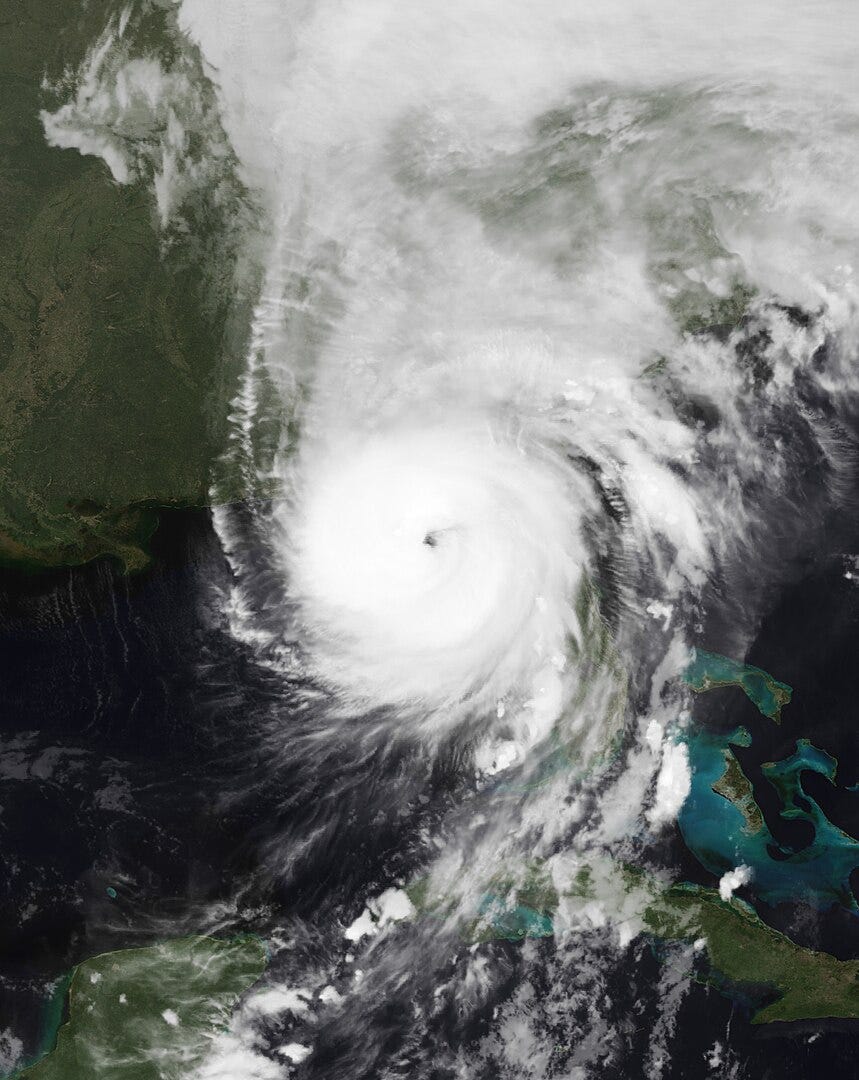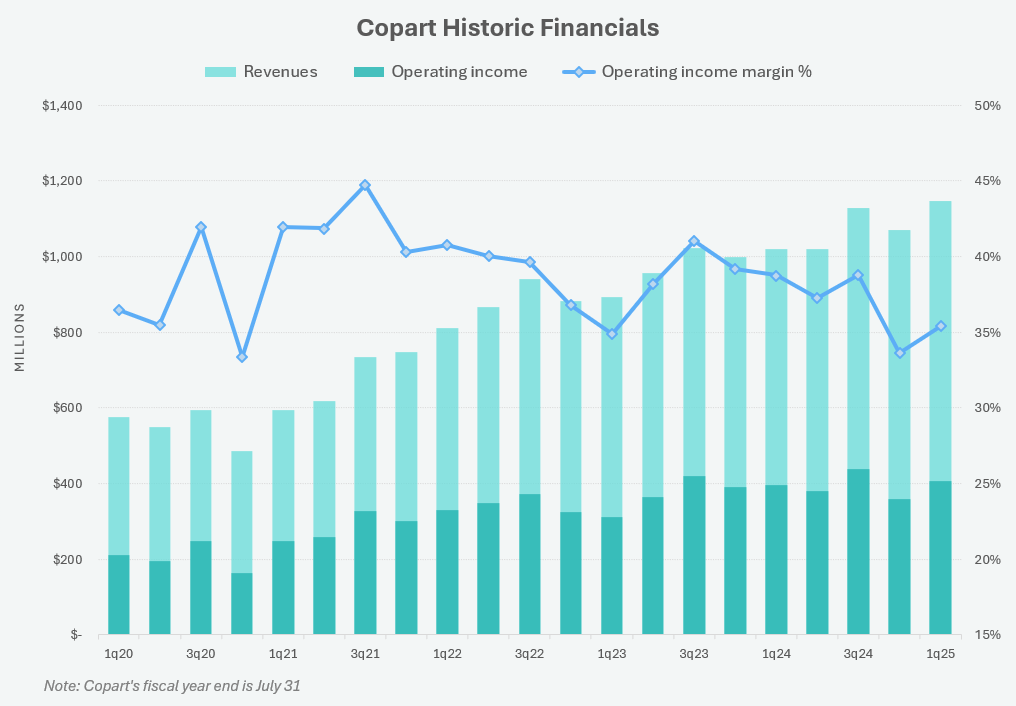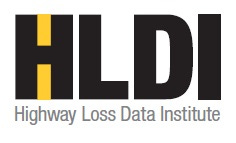Copart Q1 2025 Update
Trends Remain in Place; Plus, New Data on Time for Safety Features to Fully Penetrate Auto Fleets
“[A]s we look forward on a 5-, 10- and 20-year horizon, our baseline expectation continues to be of ongoing organic industry growth as population and vehicle miles traveled trends—plus total loss frequency most importantly of all—more than offset declining accident frequency, as safety technologies penetrates new vehicle shipments and eventually the drivable fleet.”
—Jeff Liaw, CEO, Copart Q1 2025 call
Copart reported results for Q1 2025 (quarter end 10/31/24). The company beat expectations this quarter and the stock price closed up 10.2% the day after. Compare this to Q4 2024 when results failed to beat expectations and the stock price closed down 6.7% the day after. Such is the life of a publicly traded company.
Notable results and expectations for this quarter include:
Copart’s insurance business grew approximately 13% for the quarter in unit volume. When excluding the effect of catastrophic events, Copart grew 9% year-over-year for the quarter;
Total loss frequency for the industry was 21.7% at the end of September;
Copart’s Blue Car business, which serves bank and finance, fleet and rental customers, grew 20% year-over-year; and
Copart expects investments in SG&A to “partially recede over the next 12 months” which will provide “strong operating leverage in the future”.
Financials
Below are the quarterly results of Copart going back to 1Q 2020.
Despite continued capital and operating expenditures in the U.S. and abroad, Copart’s cash continues to pile up.
Hurricane Response

During 2023, hurricane activity was not meaningful. CEO Jeff Liaw spoke on Copart’s Q4 2023 call about the company’s obligation to its insurance customers (emphasis mine):
“We were prepared to immediately retrieve inventory store process titles for and sell many thousands of vehicles in the affected areas. And of course, our real estate investment and planning had begun years in advance, yielding more than 600 available acres of dedicated cab storage in Florida alone. For a given storm quarter or year, our investments in catastrophic readiness may appear to be overkill, but we recognize the responsibility we have to our customers and to the communities we serve together to optimize our readiness for such severe weather events.”
This year, 2024, was a different story. During the prior quarter, two large hurricanes struck the Southeast United States: Helene in late September and Milton less than two weeks later in early October. In addition to the general devastation of homes and the uprooting of the lives of many people, CARFAX estimated Helene damaged 138,000 vehicles across the Southeast while Milton damaged 120,000 in Florida. Although back-to-back hurricanes added complexity which Copart had not experienced before, Copart’s response was outstanding (emphasis mine):
“In comparison to Hurricane Ian, a similarly scaled and located storm from just 2 years ago, our advanced preparation and our team’s execution this time around yielded still better results with approximately twice as many vehicles picked up in the first 10 days of these 2024 storms in comparison to Ian in 2022.”
—Jeff Liaw, CEO, Copart Q1 2025 call
Furthermore (emphasis mine):
“[B]y the end of October, just 3 weeks after landfall for Milton, we had sold approximately 1/4 of all of the assigned vehicles we would ultimately receive from both Helene and Milton. In fact, according to one third-party source, 3 out of every 4 catastrophic units sold in Florida during the month of October were sold on Copart’s auction platform, a reflection both of our presence as well as the speed of our execution.”
—Jeff Liaw, CEO, Copart Q1 2025 call
These are the results that Copart’s insurance customers prize and why they have rewarded the company with a dominant share of the auto salvage market. Copart has gladly invested hundreds of millions of dollars to be able to respond quickly to catastrophic weather events.
Catastrophe Prep
It’s important to remember the key enablers of Copart’s response to natural catastrophes.
First, Copart now holds in reserve 2,000 acres of storage across the nation for catastrophes. In the hurricane prone Southeast, Copart holds 1,000 acres in reserve to process storm-damaged vehicles. Second, Copart has invested in technology that helps their employees and their third-party towing network optimize routing, dispatching, and processing. Finally, Copart has continually invested over the years to create a large towing network consisting of full-time employees and owned equipment, as well as contracted third-parties.
Auto Salvage Trends and Tailwinds
The major trend of increasing total loss frequency for damaged vehicles remains firmly in place. At the end of September, CCC Intelligent solutions reported a total loss frequency of 21.7%, an increase of almost two percentage points from the prior year’s quarter. Although many new technologies in cars have reduced the frequency of accidents, these new technologies have also increased the cost of repairs. Since 1990, total loss frequency has increased fourfold.
Another important trend for Copart and the auto salvage industry is population growth. While reduction in number of accidents per vehicle miles traveled is a negative for Copart, population growth of about 1% per year in the United States has been an underappreciated and offsetting factor.
“So over the past 30 years, the Department of Transportation has published data on police reported crashes. There is one anomalous trend from the 2014 to 2018 period, I think, marked likely by the proliferation of smartphones and the addictive apps that certainly afflict us all that caused accident rates actually to increase in certain years during that period. But nonetheless, over the decades long horizon we’ve seen a steady decline in accidents per miles driven. And in fact, today versus 1990, there are approximately 1/3 fewer crashes and fatalities per million miles driven. But in absolute terms, that decline has only been 8% because of the offsetting effects of the growth in population in vehicle miles traveled.”
—Jeff Liaw, Copart Q1 2025 call
Delving into the vehicle miles driven data, I put together a chart that hopefully gives us all a better appreciation for the amount of driving that happens in this country. From 1980, vehicle miles traveled increased at a fairly constant rate until 2007. It declined during the Great Financial Crisis of 2008 and then remained at a depressed level for a while. But since 2014, the total miles driven over most 12-month periods in this country has been well over 3 trillion. You can also see the dramatic decline in vehicle miles traveled during the COVID era. In May 2024, total vehicle miles traveled surpassed the pre-COVID all-time high.
Also important to note is the dark line which represents vehicle miles traveled per capita. This figure remains depressed and is at levels last seen in 1995. With a greater number of people working from home to varying degrees, this line seems likely to remain stagnant. At best, it will increase at a much reduced rate for the foreseeable future.
Time for New Auto Safety Features to Propagate Throughout the Fleet
Given that Copart’s primary business is to assist insurance companies deal with damaged vehicles, new safety features in cars present upsides and downsides to Copart’s business. The downside for Copart is that there have been, and will likely continue to be, fewer accidents. The upside is that when there is an accident, the repair costs are much greater and thus cars are more likely to be total losses and prime candidates for Copart’s online salvage auctions.
Given that new safety features are a partial headwind for Copart, it is important to understand just how slowly new features disseminate across the entire auto fleet. The Highway Loss Data Institute (HLDI) occasionally releases reports on this subject. The charts below are from its April 2023 update. The chart below shows the percentage of all registered vehicles in 2022 with various safety features along with a prediction for what that will look like in 2027.
One worry I’ve heard multiple times regarding Copart is what effect autonomous driving will have on the business. If—and this is a big “if”—autonomous driving ever becomes standard on most of the cars out on the road, the number of accidents should be dramatically smaller. This is a potential existential threat to Copart’s business.
But let’s look at the evolution of electronic stability control (ESC). The very first iteration was introduced in 1983 on the Toyota Crown. Mercedes-Benz and Toyota then introduced a second generation of ESC in 1995 for the S 600 Coupé and Crown Majesta, respectively. From the second generation in 1995, it took about 22 years before 100% of new vehicles had this technology. However, as of 2022, ESC is only present in 70% of total registered vehicles.
Next, HLDI predicts it won’t be until 2040 or 2045 that ESC is present in 100% of all registered vehicles.
So, from the time of introduction in 1995 of the second generation of ESC, the prediction is that it will take 45-50 years before 100% of registered vehicles have this safety feature. Other safety features like rear parking sensors, front crash prevention, and lane departure warning, have similar predictions of four to five decades before becoming ubiquitous in the auto fleet since introduction.
Given what we know about the above safety features, is autonomous driving a risk to Copart? I think the answer is decidedly “no”. Adding to my confidence is the fact that autonomous driving is a much more complex technology compared to rear parking sensors.
From here, let’s engage in a thought experiment. Goldman Sachs predicts that by 2030, “up to 10% of global new car sales could be Level 3 vehicles: self-driving cars that let drivers take their eyes off the road and their hands off the wheel in select situations, such as on a highway in clear weather.” If this prediction is correct and it follows the historic trends of prior auto technologies, it would be 2045 or 2050 when all new vehicles sold have Level 3 autonomy. This would also mean ~50% of all registered vehicles would have this feature at that time. It would then be roughly the year 2075 or 2080 when 100% of registered vehicles have Level 3 autonomy. And remember, this is just Level 3 autonomy and not Level 5, which is full automation in all driving conditions.
In Summary
Copart continues to grow. The positive trends and tailwinds are firmly in place. The headwind of fewer accidents (frequency) is offset by the tailwind of increasing costs to repair damaged vehicles (severity). Sometime in 2025, Copart will likely produce $1 billion of annual free cash flow for the first time ever.
Finally, I am now even more confident that many potential Copart investors overestimate the risk of autonomous driving to Copart’s business. Varying levels of autonomous driving are unlikely to have a meaningful impact on Copart during most of our lives or even the lives of our children. Accidents will continue to be an unfortunate feature of auto fleets for generations to come. Total loss rates will continue to increase due to the increasing amount of sensors and technology in new vehicles. And Copart will always be there for its insurance companies to maximize the value of vehicles involved in accidents.
Please Subscribe
If you enjoyed this content, please share and subscribe.
See my update on Copart’s prior quarter:
Disclaimers
The content of this publication is for entertainment and educational purposes only and should not be considered a recommendation to buy or sell any particular security. The opinions expressed herein are those of Douglas Ott in his personal capacity and are subject to change without notice. Consider the investment objectives, risks, and expenses before investing.
Investment strategies managed by Andvari Associates LLC, Doug’s employer, may have a position in the securities or assets discussed in any of its writings. Doug himself may have a position in the securities or assets discussed in any of his writings. Securities mentioned may not be representative of Andvari’s or Doug’s current or future investments. Andvari or Doug may re-evaluate their holdings in any mentioned securities and may buy, sell or cover certain positions without notice.
Data sources for all charts come from SEC filings, Koyfin, and other publicly available information.












nice graphs! what software / tools did you use to build them?